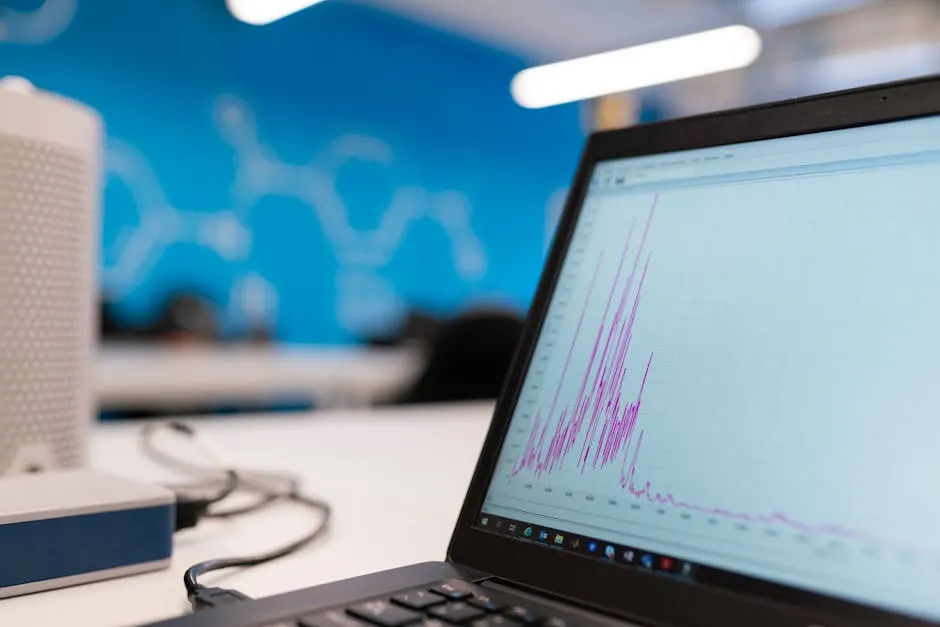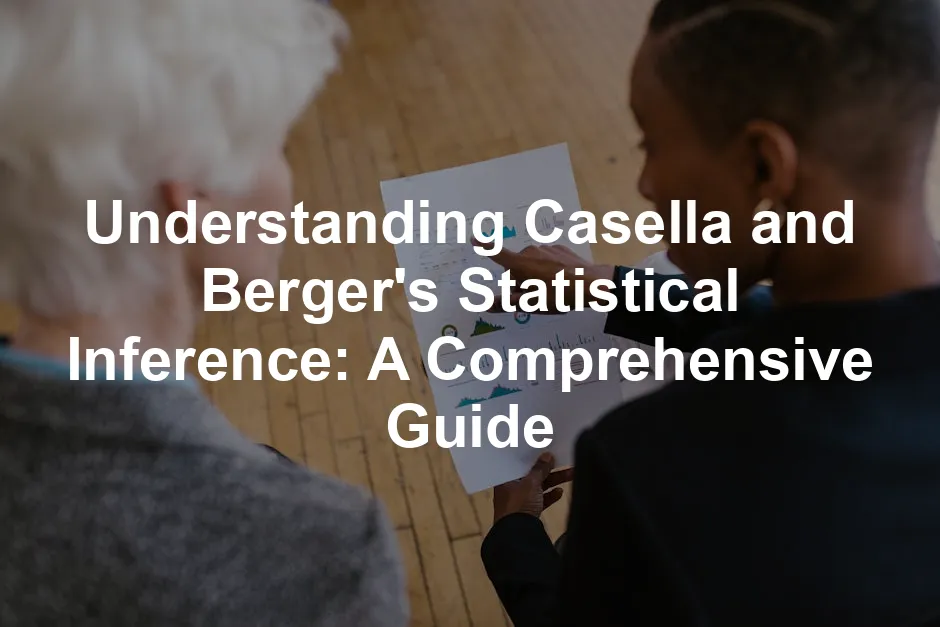Introduction
Statistical inference is the art of making conclusions about a population based on a sample. Imagine trying to guess how many jellybeans are in a giant jar. You can’t count them all, but you can take a handful, analyze it, and make a pretty good guess. That’s statistical inference! It’s crucial in data analysis and research, as it allows researchers to draw meaningful conclusions despite uncertainty.
Enter George Casella and Roger Berger, two giants in the field of statistics. Their textbook, “Statistical Inference”, has been a beacon for students and professionals alike. This book isn’t just a collection of dry formulas; it brings the subject to life! Casella and Berger brilliantly weave theory with practical applications, making statistical inference accessible and engaging.
In this article, we’ll journey through the fundamentals of statistical inference. From the basics to advanced concepts, you’ll discover insights into Casella and Berger’s textbook and learn how to apply these principles in real-world scenarios. Expect to find practical examples and a touch of humor to keep things lively! Whether you’re a student or a seasoned statistician, this guide will enhance your understanding of statistical inference and its vital role in today’s data-driven world.
So, grab your favorite snack, settle in, and let’s get started on this statistical adventure!

Key Concepts in Statistical Inference
Statistical inference is built on a few essential concepts. Let’s break them down, shall we?
Populations and Samples: A population includes every member of a defined group. Think of it like the entire audience at a concert. However, you can’t ask everyone their opinion about the band’s performance. Instead, you take a sample—like asking a handful of enthusiastic fans. This sample helps you gauge the overall vibe without needing to chat with every single person in the crowd.
Parameters and Statistics: Parameters are numerical characteristics of a population. For instance, the average height of all concert-goers is a population parameter. On the other hand, statistics are numerical characteristics derived from a sample. If you measure the average height of just your sample of fans, that’s a statistic.
Random Sampling: Here’s where it gets fun! Random sampling ensures every member of the population has an equal chance of being selected. This is crucial because it minimizes bias. Imagine if you only surveyed people near the front of the stage. You’d likely get a skewed view of the concert experience. Random sampling helps achieve a balanced perspective.
Sampling Distributions: Now, let’s talk about sampling distributions. When you take multiple samples and calculate their statistics, you create a distribution of those statistics. This distribution helps us understand the variability and reliability of our estimates. It’s like collecting different opinions about the band’s performance and seeing how they cluster around a common sentiment.
Understanding these core concepts sets the stage for deeper statistical inference. If you want to dive deeper into data analysis, consider picking up “R for Data Science” by Hadley Wickham and Garrett Grolemund, which provides a fantastic introduction to using R for data analysis.

Types of Statistical Inference
Point Estimation: Point estimation gives us a single value as an estimate of a population parameter. Picture trying to guess the average age of concert attendees. If you sample and find an average age of 24, that’s your point estimate. Simple, right?
Interval Estimation: This one’s a bit more sophisticated. Interval estimation involves creating a confidence interval—an estimated range of values that likely contains the population parameter. For example, if your confidence interval for the average age is between 22 and 26, it suggests you’re pretty confident that the true average age lies within that range. This adds a layer of certainty to your estimation.
Hypothesis Testing: Here, we’re testing assumptions. You start with a null hypothesis (H0), which posits that there’s no effect or difference. For example, assume the average age of concert-goers is 25. The alternative hypothesis (H1) suggests there is an effect or difference—perhaps the average age is not 25.
To evaluate these hypotheses, we look at potential errors. Type I error occurs when we reject a true null hypothesis, while a Type II error happens when we fail to reject a false null hypothesis. Understanding these errors is crucial for making sound statistical decisions.
These types of statistical inference provide powerful tools for researchers to draw meaningful conclusions from data. For more details on hypothesis testing, check out our statistics hypothesis testing cheat sheet. If you want to delve into the art of data interpretation, you might find “The Art of Statistics: Learning from Data” by David Spiegelhalter incredibly insightful.

Understanding hypothesis testing is crucial for making sound statistical decisions. Learn more about hypothesis testing.
Unique Features of the Textbook
Casella and Berger’s “Statistical Inference” stands out for several reasons. First, clarity reigns supreme. The authors break down complex concepts into digestible pieces, ensuring even the most bewildered reader can find their footing. This isn’t just a textbook; it’s like that insightful friend who explains tricky topics over coffee.
Practical applications are woven throughout the book. Each chapter features real-world scenarios, allowing readers to see how statistical inference plays out in daily life. Think of it as having a practical guide at your fingertips while tackling statistical challenges.
Extensive exercises add another layer of value. With hundreds of problems that range from basic to advanced, readers can test their understanding and gain confidence. Want to ensure you’re not just reading but also applying? This textbook has you covered.
The latest edition steps up its game by including topics like bootstrapping and simulation methods. These modern techniques are essential in today’s data-driven landscape. They provide valuable tools for estimating statistics without relying on traditional assumptions. If you’re curious about modern statistical analysis, consider exploring “The Elements of Statistical Learning” by Trevor Hastie, Robert Tibshirani, and Jerome Friedman.

Target Audience
This textbook is primarily aimed at graduate students delving into the world of statistics. However, advanced undergraduates with a solid grasp of calculus and basic probability can also find it beneficial. It’s perfect for those looking to transition from introductory courses to more complex statistical theories.
Prerequisites are essential to grasp the material fully. A background in calculus is necessary, as the book often uses mathematical principles to explain statistical concepts. Basic probability knowledge is also crucial; without it, some sections might feel like a foreign language.
In summary, if you’re a graduate student ready to tackle statistical inference, or an ambitious undergrad with a strong math foundation, this book will serve you well. It’s designed to transform your understanding and application of statistical principles, making it a worthy addition to your academic toolkit. If you’re also looking for a solid introduction to data science, consider “Data Science for Business” by Foster Provost and Tom Fawcett.

Statistical Software and Tools
In the realm of statistical inference, having the right tools can make a world of difference. Among the most popular statistical software are R and SAS. These programs are not just fancy calculators; they’re powerful allies for anyone looking to apply the concepts from Casella and Berger’s textbook.
R is like that friend who always brings snacks to the party—it’s free and packed with goodies! As an open-source language, R offers countless packages for statistical analysis. You can perform complex calculations, create stunning visualizations, and easily manipulate data. Plus, there’s a robust community behind it, always eager to help out. So, whether you’re testing hypotheses or estimating parameters, R has you covered. If you want to learn R, check out “Python for Data Analysis” by Wes McKinney, which complements R with Python programming.
SAS, on the other hand, is the seasoned professional in the group. Often used in corporate environments, SAS excels in data management and advanced statistical analysis. Its user-friendly interface makes it easier for those who might not be data wizards, while still providing a solid foundation for serious statistical work.
Using these tools alongside Casella and Berger’s textbook enhances your learning experience. Concepts from the book come alive when you can apply them directly in R or SAS. Want to visualize your sampling distributions or execute a hypothesis test? These platforms enable you to do just that! They facilitate the transition from theoretical knowledge to practical application, ensuring you not only understand the concepts but can also implement them in real-world scenarios.

Critiques and Reviews
Summary of Reviews
The reception of Casella and Berger’s “Statistical Inference” has been quite varied, reflecting both its strengths and areas of contention. On one hand, many students and professionals praise the book for its clarity and depth. Reviewers often highlight how the authors break down complex concepts, making them accessible even to those new to the field. One enthusiastic student noted that the book “gently builds on each topic,” which creates a solid foundation for understanding statistical inference.
However, not all feedback is glowing. Some readers find the material to be overly complex, especially for beginners. A common critique is that the depth of material can be intimidating. For those who are just dipping their toes into statistics, jumping into the intricate discussions without sufficient background can feel like being tossed into the deep end of the pool.
Another point of contention lies in the exercises. While many appreciate the extensive problem sets, some feel they can be too challenging, leading to frustration rather than learning. Balancing the exercises to cater to a wider range of skill levels could enhance the experience for all readers.
Comparison with Other Textbooks
When placed alongside other statistical inference textbooks, Casella and Berger’s work shines in several areas, though it also has its drawbacks. For instance, compared to “Mathematical Statistics with Applications” by Wackerly, this textbook is often regarded as more rigorous. Students preparing for graduate-level understanding will find that Casella and Berger’s book provides a solid theoretical grounding, while Wackerly leans more towards practical applications.
On the flip side, if you’re seeking a gentler introduction, “Introduction to Statistical Learning” by James et al. might be more suitable. This book is often recommended for those who want to get their feet wet before tackling the heavier theoretical content found in Casella and Berger’s textbook.
In terms of visual aids and real-world applications, Casella and Berger certainly deliver. However, some competing texts offer more intuitive design and presentation that may appeal more to visual learners. The choice ultimately depends on the reader’s background and learning style.
Overall, while Casella and Berger’s “Statistical Inference” is a formidable resource, it’s essential to consider your personal learning needs and background when choosing the right textbook. Each book offers unique benefits, so finding the one that aligns with your goals is key to mastering statistical inference. If you’d like to explore more about data mining concepts, check out “Data Mining: Concepts and Techniques” by Jiawei Han, Micheline Kamber, and Jian Pei.

Conclusion
In this article, we’ve taken a thorough look at “Statistical Inference” by George Casella and Roger Berger. We started our journey by defining statistical inference and its pivotal role in drawing conclusions from data. Understanding how populations and samples interact is crucial for anyone working with statistics. We explored key concepts, including point estimation, interval estimation, and hypothesis testing, which are the backbone of statistical analysis.
The textbook itself is a treasure trove of knowledge. It combines theoretical foundations with practical applications, making complex topics approachable. With clear explanations and a plethora of exercises, it caters to both graduate students and advanced undergraduates. It’s not just a textbook; it’s a guide that helps demystify the intricacies of statistical inference.
Understanding statistical inference isn’t just academic; it’s essential for effective data analysis in various fields. Whether you’re in healthcare, business, or social sciences, the ability to interpret data accurately can lead to better decision-making. This textbook equips readers with the necessary tools to navigate the challenges of modern data analysis. If you’re interested in understanding more about the relationship between statistics and real-world outcomes, grab a copy of “Freakonomics” by Steven D. Levitt and Stephen J. Dubner.

For those eager to deepen their knowledge, I highly encourage you to explore Casella and Berger’s textbook. It offers rich insights and methods that can be applied in diverse research areas. You’ll find that enhancing your understanding of statistical inference can significantly impact your ability to analyze data and draw actionable conclusions. So, grab a copy and unlock the potential of statistical inference in your work!
FAQs
What is the prerequisite knowledge for studying Statistical Inference by Casella and Berger?
Before diving into “Statistical Inference,” it’s vital to have a solid mathematical foundation. A background in calculus is essential, as many concepts rely on calculus principles. Additionally, prior exposure to basic probability will serve you well. Familiarity with mathematical statistics can also be helpful, particularly if you’ve taken courses like “A First Course in Probability” by Sheldon Ross or similar textbooks.
How does this textbook compare to introductory statistics books?
“Statistical Inference” by Casella and Berger is not your average introductory statistics book. While many introductory texts focus on basic concepts and practical applications, this textbook delves deeper into the theoretical underpinnings of statistical methods. It’s designed for graduate-level students, meaning it covers topics with a level of depth and rigor that you won’t find in beginner books.
Are there any online resources or courses that complement the textbook?
Absolutely! Several online platforms offer resources and courses that align well with Casella and Berger’s textbook. Websites like Coursera, edX, and Khan Academy provide courses in statistics that cover foundational concepts and advanced techniques. Additionally, platforms like DataCamp and Udacity offer interactive programming courses that focus on applying statistical inference using software like R and Python.
Where can I purchase or access the textbook?
You can find “Statistical Inference” by Casella and Berger on various platforms. Amazon is a reliable source, offering both new and used copies. Prices typically range from around €23 for paperbacks to approximately €72 for hardcovers. Other retailers like AbeBooks and Hugendubel also list this textbook. Prices may vary depending on the condition of the book and the seller. If you’re looking for a digital version, check platforms like Google Books or Taylor & Francis, which may offer eBook formats for around €98.49.
Please let us know what you think about our content by leaving a comment down below!
Thank you for reading till here 🙂
All images from Pexels




